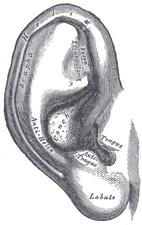Pinna (anatomy)
- Auricula or Pinna is of an ovoid form, with its larger end directed upward.
- lateral surface is irregularly concave, directed slightly forward, and presents numerous eminences and depressions to which names have been assigned
- prominent rim of the auricula is called the helix; where the helix turns downward behind, a small tubercle, the auricular tubercle of Darwin, is frequently seen
- another curved prominence, parallel with and in front of the helix, is called the antihelix
- this divides above into two crura, between which is a triangular depression, the fossa triangularis
- narrow-curved depression between the helix and the antihelix is called the scapha
- the antihelix describes a curve around a deep, capacious cavity, the concha, which is partially divided into two parts by the crus or commencement of the helix
- the upper part is termed the cymba conchæ
- the lower part the cavum conchæ
- in front of the concha, and projecting backward over the meatus, is a small pointed eminence, the tragus, so called from its being generally covered on its under surface with a tuft of hair, resembling a goat's beard.
- opposite the tragus, and separated from it by the intertragic notch, is a small tubercle, the antitragus
- below this is the lobule, composed of tough areolar and adipose tissues, and wanting the firmness and elasticity of the rest of the auricula
- the antihelix describes a curve around a deep, capacious cavity, the concha, which is partially divided into two parts by the crus or commencement of the helix
- cranial surface of the auricula presents elevations which correspond to the depressions on its lateral surface and after which they are named, e. g., eminentia conchæ, eminentia triangularis, etc.

Related pages
Create an account to add page annotations
Annotations allow you to add information to this page that would be handy to have on hand during a consultation. E.g. a website or number. This information will always show when you visit this page.